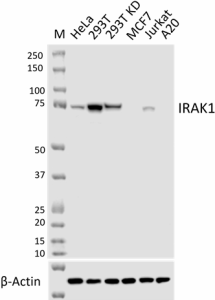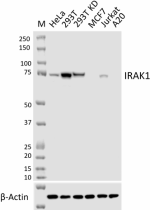- Clone
- W22166E (See other available formats)
- Regulatory Status
- RUO
- Other Names
- AA48924; Il1rak; Interleukin 1 receptor associated kinase 1; IRAK; IRAK-1
- Isotype
- Rat IgG2a, κ
- Ave. Rating
- Submit a Review

| Cat # | Size | Price | Save |
|---|---|---|---|
| 632051 | 25 µg | ¥37,400 | |
| 632052 | 100 µg | ¥96,800 |
The interleukin-1 receptor-associated kinase (IRAK) family of proteins are made up of serine/threonine-specific kinases which play a critical role in the response to pathogens through the induction of acute inflammation and subsequent adaptive immune responses. The mammalian IRAK molecular family consists of four members (IRAK1, IRAK2, IRAK3/IRAK-M, and IRAK4). Two are active kinases, IRAK1 and IRAK4, and two are inactive kinases, IRAK2 and IRAKM. However, all are involved in the regulation of the nuclear factor-κB (NF-κB) and mitogen-activated protein kinase (MAPK) pathways. The binding of IL-1 to IL-1 receptor type I (IL-1RI) initiates the formation of a complex that includes IL-1R1, IL-1RAcP, MyD88, and IRAKs. Currently, there are three differentially spliced variants of IRAK1: IRAK1, IRAK1b, and IRAK1c. Auto-phosphorylation plays a role in IRAK-1 activation and mediates proteasome-mediated degradation leading to IRAK1 protein loss. Meanwhile, IRAK1b lacks kinase activity and is resistant to proteasome-mediated degradation. Additionally, IRAK1c has a truncated sequence and is therefore mutated at the C-terminus of its kinase domain and acts as a negative regulator of the TLR and IL-1R signaling pathways.
Product DetailsProduct Details
- Verified Reactivity
- Human
- Antibody Type
- Monoclonal
- Host Species
- Rat
- Immunogen
- Partial recombinant human IRAK1 protein
- Formulation
- Phosphate-buffered solution, pH 7.2, containing 0.09% sodium azide
- Preparation
- The antibody was purified by affinity chromatography.
- Concentration
- 0.5 mg/mL
- Storage & Handling
- The antibody solution should be stored undiluted between 2°C and 8°C.
- Application
-
WB - Quality tested
ICC - Verified - Recommended Usage
-
Each lot of this antibody is quality control tested by western blotting. For western blotting, the suggested use of this reagent is 0.125 - 1.0 µg/mL. For immunocytochemistry, a concentration range of 1 - 5 μg/mL is recommended. It is recommended that the reagent be titrated for optimal performance for each application.
- Application Notes
-
For immunocytochemistry (ICC), we recommend using 4% PFA fixation followed by permeabilization with 0.5% Triton X-100 or ice cold-methanol, or ice-cold methanol fixation.
This product is not recommended for use in immunohistochemistry (IHC). - Additional Product Notes
-
This antibody has been tested in knockout/knockdown models for Western Blotting (WB).
- RRID
-
AB_3097576 (BioLegend Cat. No. 632051)
AB_3097576 (BioLegend Cat. No. 632052)
Antigen Details
- Structure
- IRAK1 protein is a 712 amino acid protein with a predicted molecular weight of 77 kD
- Distribution
-
Isoform 1 and isoform 2 are ubiquitously expressed in all tissues examined, with isoform 1 being more strongly expressed than isoform 2.
- Function
- Serine/threonine protein kinase
- Interaction
- TRAF6, PELI1, IRAK4, MYD88, TOLLIP, IL1RL1, IKBKG/NEMO, IRAK4, PELI3, INAVA and NFATC4
- Cell Type
- Macrophages, Monocytes
- Biology Area
- Cell Biology, Immunology, Innate Immunity
- Molecular Family
- Protein Kinases/Phosphatase
- Antigen References
-
- Dinarello CA. 1996. Blood. 87:2095-147.
- Takaesu G, et al. 2001. Mol Cell Biol. 21: 2475-84.
- Janssens S & Beyaert R. 2003. Mol Cell. 11:293-302.
- Jain A, et al. 2014. Front Immunol. 5:553.
- Gottipati S, et al. 2008. Cell Signal. 20:269-76.
- Gene ID
- 3654 View all products for this Gene ID
- UniProt
- View information about IRAK1 on UniProt.org
Related FAQs
Other Formats
View All IRAK1 Reagents Request Custom Conjugation| Description | Clone | Applications |
|---|---|---|
| Purified anti-IRAK1 | W22166E | WB,ICC |
Compare Data Across All Formats
This data display is provided for general comparisons between formats.
Your actual data may vary due to variations in samples, target cells, instruments and their settings, staining conditions, and other factors.
If you need assistance with selecting the best format contact our expert technical support team.















Follow Us